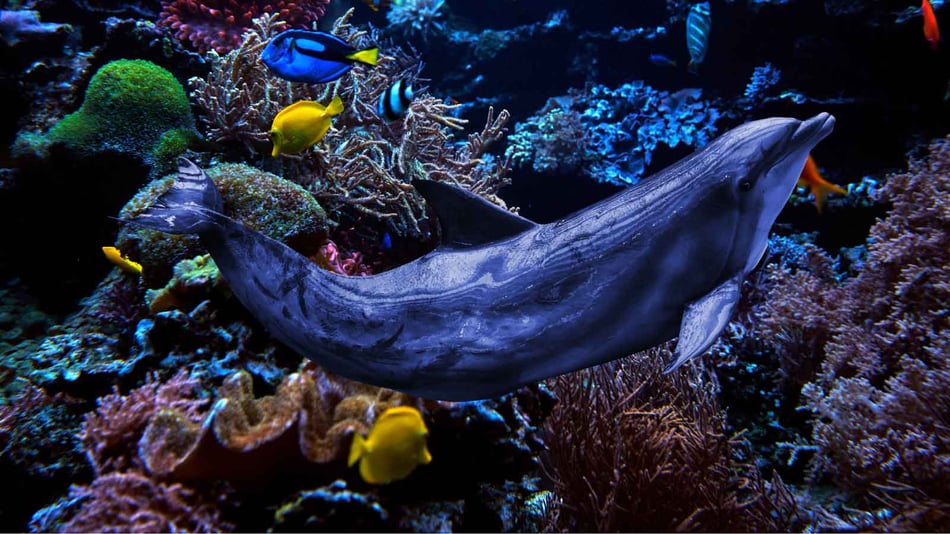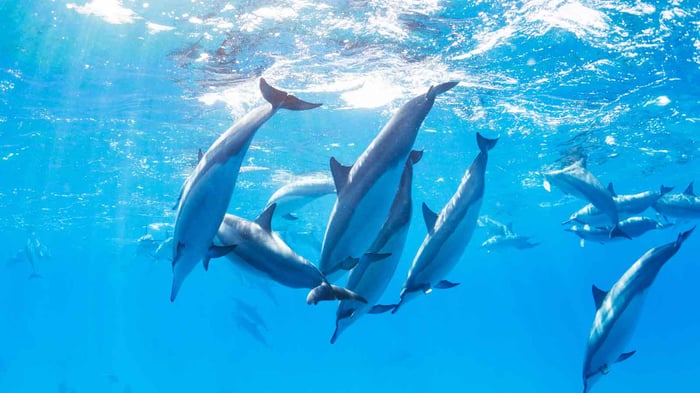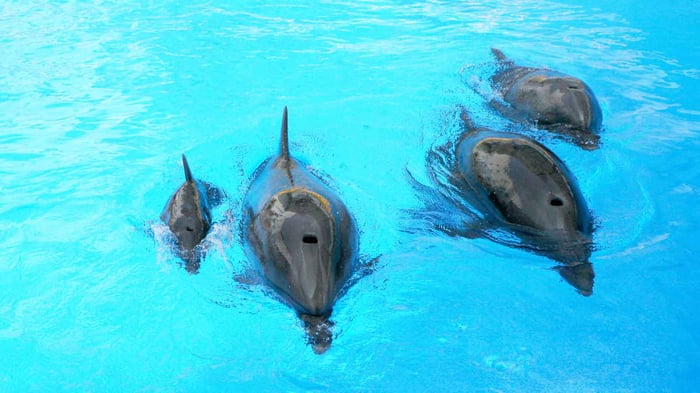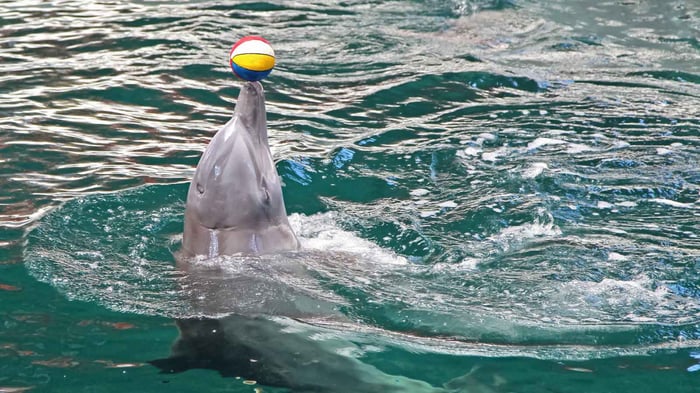Ocean Einsteins: Exploring the genius minds of dolphins

Tin
4
min. read

Can you imagine a creature that, despite not having hands or the ability to walk on land, can still demonstrate problem-solving skills comparable to those of primates?
In the oceans, marine intelligence is not just about the capacity for tool use or intricate communication; it's about adaptation, survival, and the intricate dance of life that plays out beneath the waves.
Understanding the cognitive abilities of marine species offers us a window into the evolutionary power of nature. It provides insight into how different species, including our own, have developed unique strategies to interact with, adapt to, and thrive in their environments.

Dolphins: A Brief Overview
Dolphins belong to the family Delphinidae and are a part of the order Cetacea, which also includes whales and porpoises. With over 40 distinct species, dolphins are found in every ocean on the planet.
Physically, dolphins are easily identifiable by their conical teeth and pronounced dorsal fins. Additionally, they possess a melon—an organ in their head used for echolocation—a method they employ to communicate, navigate, and hunt in the often murky depths.

A striking feature of dolphins is their intricate social structure. They often live in groups called pods. These pods enable learning, play, and protection, highlighting the species' emphasis on community and collaboration. The social bonds within a pod are strong, with members often seen leaping, surfing, and even caressing one another, reinforcing the idea that dolphins are not just intelligent, but also deeply emotional beings.
Dolphin Languages
Dolphins have an array of vocalizations and at the heart of these vocalizations are clicks, whistles, and burst-pulsed sounds—each with its unique role and significance:
1. Clicks: Dolphins use clicks primarily for echolocation, a biological sonar system. By emitting a series of high-frequency clicks and listening for their echoes, dolphins can detect the size, shape, speed, distance, direction, and even some of the internal structures of objects around them.
2. Whistles: Whistles are believed to play a pivotal role in social interactions. Each dolphin has a signature whistle, somewhat akin to a human's name, which it uses to identify itself. When separated from its pod, a dolphin might emit its signature whistle to announce its location or convey distress.
3. Burst-pulsed sounds: These are rapid sequences of clicks that can express a multitude of emotions from playfulness to aggression. When two dolphins are in disagreement, for instance, they might use these sounds as a form of reprimand or to establish dominance.
As we continue to study and decode how dolphins use language, we're not just learning about them, but also gaining insights into the vast potential of communication in the natural world.
Social Learning and Cultural Transmission

Social learning in dolphins is a powerful tool. Younger dolphins acquire knowledge by watching mature members of their pod. For instance, when a dolphin devises a new method to hunt or navigate, it doesn't take long for others to catch on. This is not mere imitation but an adaptive strategy that facilitates survival.
Dolphins also create and pass on traditions. Different dolphin communities around the world exhibit unique behaviors not driven by genetics or environmental necessity but by learned traditions. For instance, in one region, you might find dolphins using marine sponges as protective tools while foraging on the seafloor, a behavior not observed in other groups.

Games and playful interactions are also a significant part of the dolphin's cultural tapestry. From seaweed-tossing to synchronized acrobatics, these games are not just for fun but for learning social skills, too.
Emotions and Empathy
Just like humans, dolphins can express joy, curiosity, frustration, and even grief. Their highly developed neocortex, a part of the brain associated with perception, reasoning, and motor commands, is a testament to their emotional capacity.
One of the most touching demonstrations of dolphin emotions is how they deal with loss. Grieving behaviors such as lingering around deceased group members, touching them with their fins or attempting to keep them afloat, are similar to the sadness humans show with the loss of a loved one. When it comes to humans, there are numerous tales abound of dolphins saving drowning humans by pushing them to the surface or guiding lost swimmers back to shore.
These emotional displays and empathetic behaviors give us a glimpse into the dolphin's soul, teaching us that the animal kingdom is not just about survival but also about emotions, connections, and compassion.

Understanding dolphin intelligence isn't just about appreciating their brilliance; it's a lens through which we view the broader marine ecosystem. This understanding underscores the significance of each creature in the delicate balance of marine life and their interconnectedness.
To safeguard dolphins is to preserve a piece of the world's intelligence, culture, and heart. Let the marvel of dolphin intelligence serve as a reminder that our actions on land have far-reaching consequences beneath the waves.
At IMARCS, our mission and vision are inspired by such wonders of the marine world. Just as we marvel at the intelligence of dolphins, recognizing them as sentient beings deserving of respect and compassion, we also see the oceans as more than just vast bodies of water. We strive to pioneer innovative mariculture solutions that not only address pressing environmental challenges like CO2 mitigation but also ensure the thriving of all marine life.
References:
Connor, R. C. (2007, February 12). Dolphin social intelligence: complex alliance relationships in bottlenose dolphins and a consideration of selective environments for extreme brain size evolution in mammals. Philosophical Transactions of the Royal Society B: Biological Sciences, 362(1480), 587–602.
Dolphin Anatomy | Ocean Today. (n.d.). Dolphin Anatomy | Ocean Today. https://oceantoday.noaa.gov/dolphinanatomy/
Fox, K. C. R., Muthukrishna, M., & Shultz, S. (2017, October 16). The social and cultural roots of whale and dolphin brains. Nature Ecology & Evolution, 1(11), 1699–1705.
Griffiths, S. (2014, March 19). Bottlenose dolphins use sponges to protect their sensitive noses. Mail Online. https://www.dailymail.co.uk/sciencetech/article-2583451/Dolphins-use-sponges-protect-sensitive-noses-foraging-food-sea-floor.html
Just How Intelligent Are Dolphins? (n.d.). Discover Magazine. https://www.discovermagazine.com/planet-earth/just-how-intelligent-are-dolphins
Kuczaj, S. A., & Eskelinen, H. C. (2014). Why do Dolphins Play? Animal Behavior and Cognition, 2(2), 113.
Kuczaj II, S. A., Gory, J. D., & Xitco Jr., M. J. (2009). How intelligent are dolphins? A partial answer based on their ability to plan their behavior when confronted with novel problems. Japanese Journal of Animal Psychology, 59(1), 99–115.